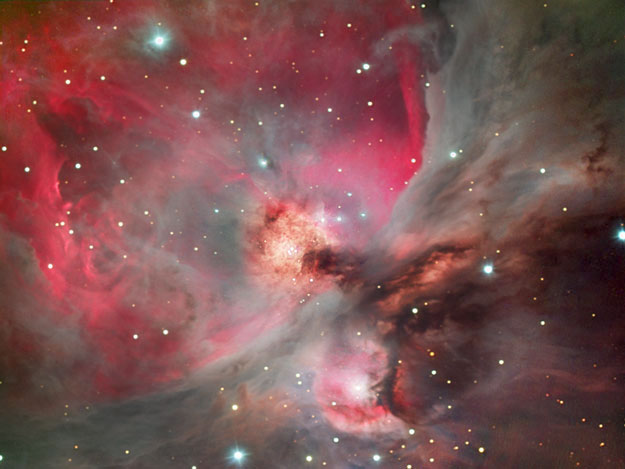Credit & Copyright: Robert Gendler
Explanation:
Few astronomical sights excite the imagination like the
nearby stellar nursery known as the
Orion Nebula.
The Nebula's glowing gas surrounds hot young stars at
the edge of an immense interstellar
molecular cloud only 1500 light-years away.
The Great Nebula in Orion can be
found with the unaided eye just below and to the left of the
easily identifiable
belt of three stars in the popular constellation Orion.
The above image has been contrast balanced to bring out Orion's detail
in spectacular fashion.
Visible simultaneously are the bright stars of the
Trapezium in
Orion's heart, the sweeping lanes of
dark dust that cross the center,
the pervasive red glowing hydrogen gas,
and the
blue tinted dust
that reflects the light of newborn stars.
The whole Orion Nebula cloud complex, which includes
the
Horsehead Nebula,
will slowly disperse over the next 100,000 years.
1999 2000 2001 2002 2003 2004 2005 2006 2007 2008 2009 2010 2011 2012 2013 2014 2015 2016 2017 2018 2019 2020 2021 2022 2023 2024 2025 |
Январь Февраль Март Апрель Май Июнь Июль Август Сентябрь Октябрь Ноябрь Декабрь |
NASA Web Site Statements, Warnings, and Disclaimers
NASA Official: Jay Norris. Specific rights apply.
A service of: LHEA at NASA / GSFC
& Michigan Tech. U.
|
Публикации с ключевыми словами:
Orion Nebula - M 42 - M 43 - Туманность Ориона
Публикации со словами: Orion Nebula - M 42 - M 43 - Туманность Ориона | |
См. также:
Все публикации на ту же тему >> | |
